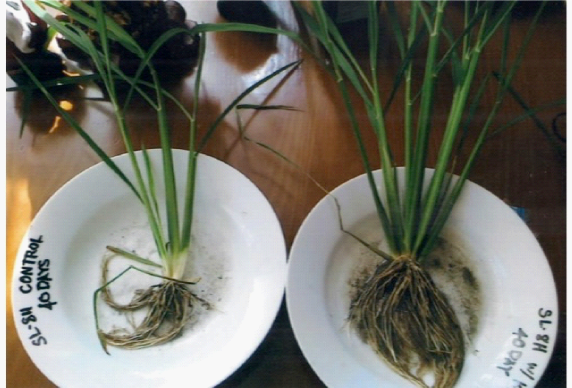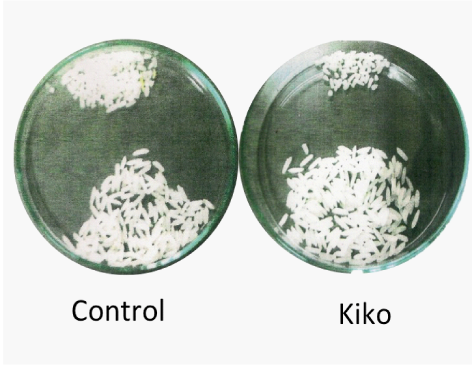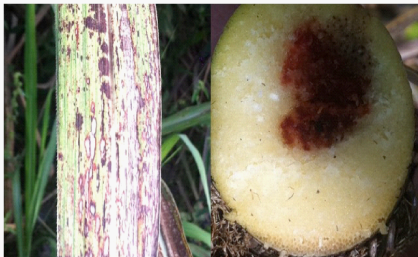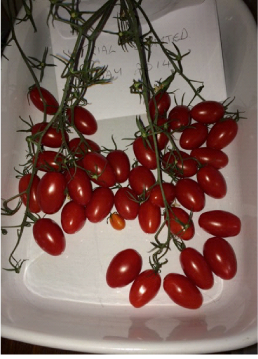Advances in
eISSN: 2373-6402


This paper describes practical applications of a new paradigm regarding benefits of using specifically activated water in agriculture. As explained elsewhere, certain water activating processes result in the loosening of intermolecular hydrogen bonding of water molecules that is seemingly mediated by an environmental force, tentatively termed KELEA (Kinetic Energy Limiting Electrostatic Attraction). While regular water does not directly absorb KELEA from the environment, the energy force can be transferred into nearby water by certain dipolar compounds, as well as by other methods. Once the water is sufficiently activated, its separated charges can directly absorb KELEA from the environment, leading to further activation. The activation can progressively extend to added water, which when utilized in agriculture can lead to improved quantity, quality and disease resistance of crops. These benefits occur through an enhanced alternative cellular energy (ACE) pathway. The use of activated water also reduces the requirements for fertilizers and pesticides. This article provides an overall summary of benefits seen in the cultivation of rice, sugarcane and various vegetables using cartridges containing pellets of heated ground volcanic rocks. The preliminary data are presented in support of further studies towards the eventual widespread beneficial use of activated water in agriculture.
Keywords: water, kinetic energy limiting electrostatic attraction, alternative cellular energy, agriculture, volcanic rock, zeolite, humic acid, rice, sugarcane
KELEA, kinetic energy limiting electrostatic attraction; ACE, alternative cellular energy; mm, millimeter; gm, gram; Rai, a 40x40 square meter land area measurement used in Thailand; Mu: a 667 square meter land area measurement used in China; LKg/TC, sugarcane production expressed as number of 50Kg bags of sugar (sucrose) per ton of harvested sugarcane, used in the Philippines; PS/TC, sucrose production expressed as the number of piculs (60Kg units) per ton, also used in the Philippines
It is acknowledged within the farming communities that water from different sources may vary in the capacity of promoting the growth of agricultural crops. The differences are typically attributed to natural variations in mineral content, hardness and/or pH of the water. Less accepted is the notion of possible differences in an intrinsic property of the actual water molecules, rather than the effects of chemical components present within the water. Unfortunately, many proponents of activated water make unsubstantiated claims, which are biased by commercial interests. Still, it would be unfortunate if some measures of these claims were to be true, but over looked by farming communities.
Based on an extensive review of many of the stated methods of improving the biological activity of water, the author has confidently concluded that the kinetic and biological activity of water can be increased by factors other than the environmental temperature.1–7 The author has further reported that activated water shows a far greater tendency to vaporize and can sustain an elevated vapor pressure in sealed containers. Neutral red dye particles sprinkled onto activated water can show rather dramatic linear dissolving patterns with to-and-fro movements. This pattern contrasts with the slow and evenly expanding dye from stationary particles sprinkled onto non-activated water. Another easily measurable difference is the increased rate of weight reduction in closed, but not completely sealed, containers of activated water. Typical 6hour results are<0.1mg/ml prior to activation, and >0.5 to 5mg/ml following activation. These phenomena persist and can even increase over time consistent with an ongoing, environmentally driven water-activating process. A hypothesis was proposed1 to explain this process in terms of an absorbed kinetic energy limiting electrostatic attraction (KELEA).
Among the various water activation methods examined, several comprise the use of heated ceramic materials.1 The heating process is likely to result in preferential hydrogen versus covalent intermolecular bonding. The increased dipolar electrical charge separation facilitates KELEA attraction and the potential energy transfer to nearby water. One such product is composed of ground volcanic rocks heated to ~1,300°C and formed into small pebble-like stones. These stones/pellets are placed into perforated cartridges measuring 20mmx128mm (Figure 1). The cartridges are inserted into the ground, although they can be alternatively placed directly into the water used for irrigation. This particular product, referred to as Kiko Technology, is discussed in this paper because it has been extensively evaluated in actual field trials of farming operations. This has allowed direct comparisons with the crops grown in control fields using regular water. The crops evaluated include rice, sugarcane, and various vegetables.
Data from 10 completed studies were reviewed. The studies were conducted in the Philippines (x4); Thailand (x2); Vietnam (x2); Taiwan (x1); and Australia (x1). Kiko cartridges were inserted vertically just beneath the soil surface at one per 40 square meters in Thailand (1rai) and five per hectare, that is one per 45square meters, in other countries. Rice productivity and other observations in the Kiko-treated plots were compared with comparably sized plots not containing Kiko cartridges. Distances of 200-800meters separated the test and control plots.
All of the testing farmers reported increased harvesting of higher quality rice from the Kiko-treated fields compared to the harvests from the control fields. Quantitative yield data of control versus Kiko harvests from the Philippines ranged from 3.7 versus 4.1 tons per hectare to an impressive differential of 2.3 versus 5.4 tons per hectare. One of the Thai studies reported an increase in Kg per rai equivalent to an increase from 3.8 to 5.5 tons per hectare. Actual harvest data from some of the Asian studies were not available other than statements from the farmers of noticeably improved yields.
A consistent initial observation was a greener hue of rice plants in the Kiko-treated plots. At regular intervals, individual plants from the test and control plots were compared. These comparisons showed that compared with the matching control plots, Kiko-treated plots produced taller plants with greener leaves; with root systems that were denser, darker and longer, (Figure 2); and with stalks that were sturdier and more tolerant of bending in high winds.
Various measures confirmed the enhanced production of higher quality rice plants from the Kiko-treated fields. For example in the Thai study, there was increase in tiller counts per stalk from 5-15 in control plants to 15-23 in treated plants; and panicles count per square meter from 148-280 in control plants to 265-382, in plants from the matching Kiko-treated fields. Rice grains from Kiko-treated fields were consistently larger, whiter and more pearlescent in color than grains harvested from the control fields. The grains also contained fewer (e.g. 25%) broken forms than those harvested from plants in the corresponding control plot (e.g. 38%)(Figure 3). Furthermore, the results from one of the studies showed 29.0gm versus 21.8gm milled rice per 1,000 rice grains. Southeast Asian and Filipino farmers further noted both greater numbers and added weight of each filled cavan sacks. For example in one of the Philippine studies 80 cavans weighed on average 58 Kg from the Kiko treated plot compared to only 48 cavans, with an average weight of 55 Kg harvested from the comparable control plot.


Highly reliable harvesting quantitation has come from a major long grain rice grower in Australia. An ex-president of the National Farmers Federation independently oversaw the study. It was conducted on 4-hectare plots, 800 meters apart. The palay (pre-husked rice) yield per hectare in the Kiko treated plot was 12.85 tons per hectare, compared to the control yield of 11.17 tons per hectare. Moreover, the farmer had not previously harvested such a high level of productivity as was achieved using Kiko cartridges. Furthermore, the increased productivity occurred even though the cartridges were not placed into the ground of the test plot until 8weeks after planting (30% of the crop growth time).
Contributing to the greater rice yields, the Philippines, Thailand and Vietnam studies showed a marked reduction in pest infestation. An invasion by Kuhol snails (Pomacea caniculata)8 occurred in one of the Philippine sites but only involved the control and not the Kiko-treated field. Another rice farmer from the Philippines experienced an outbreak of rice tungro bacilliform virus (RTBV) infection.9 It was reported as being milder and of shorter duration in the Kiko-treated field. All of the farmers reported markedly reduced rodent infestation in the Kiko-treated field. A Philippine farmer was seeing over a hundred rodents a day in his control field but on average seeing only three a day in the Kiko-treated field. A Thai farmer saw no rodents in the Kiko-treated field, yet was trapping 6 rodents a day in the control field. There have been significant reductions in the pesticide use, resulting from lower pest infestation in the Kiko-treated plots.
Ongoing additional applications of Kiko-treated water in rice farming now include soaking of the rice seeds for 24-48hours in 100liters of water containing a Kiko cartridge, prior to transfer to the nursery growing of the seedlings. This practice is supported by earlier studies showing rice seeds placed in Kiko-water germinated faster and at a higher percentage (e.g. 96% vs. 85% in one study) than seeds placed into regular water. The Vietnamese farmer now uses one-third less fertilizer, while another farmer no longer uses lime since in the initial study the soil pH in the Kiko-treated field naturally raised from 5.5 at the time of seeding to 7.0 at the time of harvest. Other farmers have also reported stabilization of pH value of the soil in Kiko-treated fields with rather constant values of 6.8 to 7.8 in the different test sites over extended periods of time.
Sugarcane studies were completed in the Luzon region of the Philippines with highly encouraging results. The study was conducted on 3.3 hectares divided evenly into different test and control areas. It was begun in January 2013 and extended through to February 2014. Sugarcane segments of the PHIL 74-64 variety were placed into either regular water or water treated with a single Kiko cartridge for varying periods ranging from 1-24hours prior to being planted. Kiko cartridges were inserted into the soil of the test areas at 1 cartridge per 72square meters. This was actually less cartridges than used in earlier positive sugarcane studies in which individual cartridges were placed into areas of 10 to 20square meters.
Striking differences were noted in both the quantity and the quality of the resulting sugarcane. There was a greater number and earlier germination of sugarcane segments in the Kiko-treated compared with control water. The average germination yields in 4 duplicate studies using Kiko water for 8, 12 and 24hours were 25, 24 and 27 segments with roots suitable for plantation, respectively; compared to the control water average values for the 3 time periods of 15, 20 and 20 segments with roots suitable for plantation. At 3 months following planting, the successful growth of plants in the three areas planted with Kiko-germinated segments was 100% compared to an average of 73% for the corresponding three areas planted with segments germinated in control water.
The sugarcane harvest, expressed as tons per hectare averaged 105 in the three comparison Kiko-treated plots versus 93 in the corresponding three control areas. The sugarcane from the Kiko-treated field was still in the growing phase with green stalks (reflective of chlorophyll content) compared to the more yellowish sugarcane harvested from the control field (Figure 4). As can also be seen in this Figure, the width, intermodal lengths and nodal tillering of the sugarcane from the test field exceeded those of the control sugarcane. The sucrose content expressed as piculs (60Kg) per ton (PS/TC) from one of the Kiko-treated plots was 1.50, whereas that from its corresponding control plot was 1.35. This increase was similarly reflected in the increased number of 50Kg bags of sugar per ton (LKg/TC), being 1.90 in another of the Kiko-treated plots versus 1.71 in its corresponding control plot. These differences would likely to have been greater if the harvesting of the still growing sugarcane from the Kiko-treated plots was delayed till full maturity of the plants. Adding to the increased productivity in the Kiko-treated fields was the complete absence of damage from Downy mildew (Peronosclerospora sacchari)10 and from white grub borers (Diatraea saccharalis)11 present in the sugarcane from the control areas (Figure 5). Rat bites to the sugarcane were also noted in the control fields but not in the Kiko-treated field. Farmers involved in earlier uncontrolled sugarcane studies have similarly reported on reduced or absent infestation of crops grown in Kiko-treated soil.


Several Australian sugarcane farmers have adopted Kiko Technology with confirmation of enhanced growth and increased sugar yields. One farmer reported a yield of 105 tons per hectare from a Kiko-treated plot compared to 70tons per hectare in an untreated plot, along with an absence of Downy mildew9 infestation in the Kiko-treated plot.
Kiko volcanic rock pellets have been used in the cultivation of numerous vegetables, as well as in aquaculture of fish (unpublished). The vegetables for which direct comparisons have been made between harvests from treated and untreated fields include tomatoes, apples, strawberries, spinach, lettuce, basil, celery, wheat grass, soybean, zucchini, okra, peanuts, chili, capsicums and aquatic plants. In addition to the roughly 30% increased yields, farmers reported improved taste and longer shelf life (beyond 40days in the case of tomatoes) (Figure 6). In each study farmers noted stalks were studier, thicker and had more deeply penetrating roots. An example is shown in the comparison of a representative soybean plant from a Kiko-treated and from a nearby untreated field (Figure 7). The use of Kiko Technology has consistently led the farmers to use less fertilizer and harvest earlier than in prior years. For spinach, the harvesting time in one Chinese study was reduced from 38-40days to 30-32days, with a 30% increased yield by weight from 2,497Kg/Mu to 2,997Kg/Mu (Mu is a Chinese equivalent to 667 square meters).


This mini-review underscores the potential enormous impact on the world’s food supply that is achievable by utilizing simple technologies that modify water quality. The consistency of positive findings in multiple studies adds credence to the basic proposition that plants respond differentially to variations in water that are unrelated to alterations in mineral content or to other components. While lacking the direct comparisons between treated and control agricultural areas as provided in this paper, enhanced crop yields have been attributed to the application of many mineral rich natural materials, such as humic and fulvic acids, zeolites, shungite (a product from Russia), volcanic rock (as in the Kiko technology), magnesium oxide and mica. While commonly regarded as only providing useful minerals and/or removing heavy toxic minerals, laboratory studies conducted by the author show that they all have considerable intrinsic water activating activity.1 This activity can be greatly enhanced by heating the materials to between 1,000°C to 1,500°C during or after the extraction process. The author has shown1 that once water is sufficiently activated, the activating compound can be removed either by progressive dilution as in homeopathy6,12 or by passage through zero-residue filters, eliminating any concerns about possible toxicity of the activating compounds. The Kiko Technology pellets do not release discernable amounts of minerals when placed in water. Yet, water exposed to Kiko pellets exhibits a lower surface tension, faster magnetic resonance and increases in both the absorption and emission of far-infrared radiation (www.kikotrechnology.com). It is possible to slowly activate water by placing it close to previously activated water or to some of the heated mineral-rich materials described above. One practice has been to encase the activating material into a resin in the form of varying sized balls. KELEA absorbing and transmitting electromagnetic devices, which have similar non-chemical, activating effects on water will be discussed in a future review.
The biological benefits of activated water are envisioned to comprise the third or the alternative cellular energy (ACE) pathway.1 The first energy pathway of Nature is photosynthesis, in which sunlight-derived energy in conjunction with chlorophyll combines carbon dioxide with water to produce sugar. In the second energy pathway of Nature, food is metabolized along with oxygen to add phosphate to adenosine diphosphate (ADP) to create the high-energy molecule adenosine triphosphate (ATP). This molecule is used as a source of chemical energy in numerous biochemical pathways. The ACE pathway is an inducible dynamic quality of fluids. It appears capable of facilitating many biochemical reactions, such as reducing the normally required concentrations of enzymes,4 facilitating the flow of biological fluids and adding to cellular resistance to pathogens.1
In regards to this last issue, a common finding with various soil amendments is reduced pest and disease infestation of cultivated crops grown in treated plots. The examples cited in the present paper using Kiko technology include the significant lessening of crop damage from rodents, insects (white grubs), snails, fungus and viruses. This observed benefit could clearly lead to a reduction in the requirement for toxic pesticides and/or to less need for pesticide resistant genetically modified crops.13
The lack of controlled studies has been a major impediment to the acceptance that water can variably enhance the quantity and quality of agricultural crops. Also limiting has been the lack of a perceived mechanism of action, whereby water molecules could be altered in a manner that enhances their intrinsic biological activity. This review addresses both issues. First, it describes a series of field studies performed over the last several years using one particular water activating product. It is suggested that this and related products can attract an environmental force termed KELEA (kinetic energy limiting electrostatic attraction) and transfer the energy to nearby water. Increased kinetic activity of biological water is regarded as a major component of a third or alternative cellular energy (ACE) pathway. An important opportunity exists to proceed rapidly with confirmatory and comparative studies using the various available means of activating water for use in agriculture.
I thank Mr. James T. Osugi, Founder Kiko Technology Ltd., for permission to review and report on the field trials.
The author has no current nor has he had any prior financial arrangement with Kiko Technology Ltd. or with Mr. Osugi. The Institute of Progressive Medicine is a component of MI Hope Inc., a non-profit public charity. It advocates the use of various methods of activating water for human, animal, agricultural and industrial uses.

© . This is an open access article distributed under the terms of the, which permits unrestricted use, distribution, and build upon your work non-commercially.